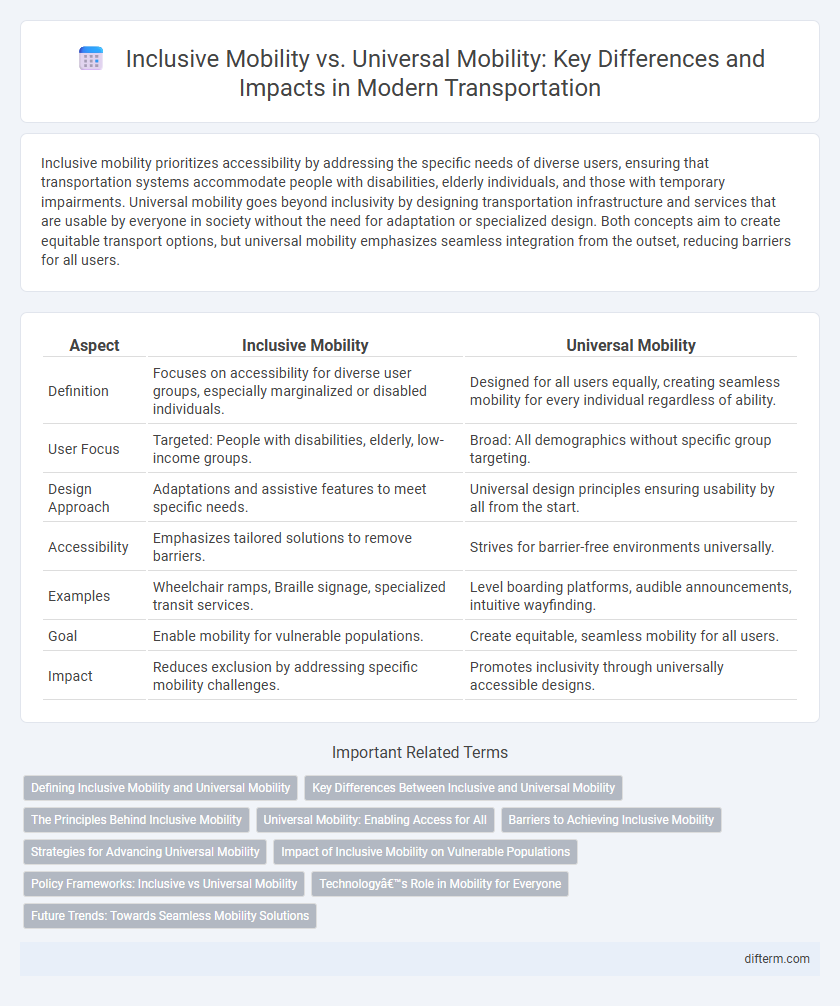Inclusive mobility prioritizes accessibility by addressing the specific needs of diverse users, ensuring that transportation systems accommodate people with disabilities, elderly individuals, and those with temporary impairments. Universal mobility goes beyond inclusivity by designing transportation infrastructure and services that are usable by everyone in society without the need for adaptation or specialized design. Both concepts aim to create equitable transport options, but universal mobility emphasizes seamless integration from the outset, reducing barriers for all users.
Table of Comparison
| Aspect | Inclusive Mobility | Universal Mobility |
|---|---|---|
| Definition | Focuses on accessibility for diverse user groups, especially marginalized or disabled individuals. | Designed for all users equally, creating seamless mobility for every individual regardless of ability. |
| User Focus | Targeted: People with disabilities, elderly, low-income groups. | Broad: All demographics without specific group targeting. |
| Design Approach | Adaptations and assistive features to meet specific needs. | Universal design principles ensuring usability by all from the start. |
| Accessibility | Emphasizes tailored solutions to remove barriers. | Strives for barrier-free environments universally. |
| Examples | Wheelchair ramps, Braille signage, specialized transit services. | Level boarding platforms, audible announcements, intuitive wayfinding. |
| Goal | Enable mobility for vulnerable populations. | Create equitable, seamless mobility for all users. |
| Impact | Reduces exclusion by addressing specific mobility challenges. | Promotes inclusivity through universally accessible designs. |
Defining Inclusive Mobility and Universal Mobility
Inclusive mobility emphasizes creating transportation systems that accommodate diverse user needs, including people with disabilities, the elderly, and economically disadvantaged groups. Universal mobility refers to designing transport solutions accessible and usable by everyone, regardless of physical ability or social status, aiming for complete accessibility and equality. Both concepts prioritize accessibility but differ in scope, with inclusive mobility targeting specific vulnerable groups and universal mobility advocating for broad, all-encompassing access.
Key Differences Between Inclusive and Universal Mobility
Inclusive mobility emphasizes tailored solutions that address specific barriers faced by individuals with disabilities, promoting accessibility within existing transportation systems. Universal mobility aims to design transportation infrastructure and services that accommodate all users from the outset, ensuring seamless access regardless of age, ability, or socioeconomic status. The key difference lies in inclusive mobility's focus on integration and adaptation versus universal mobility's goal of creating inherently accessible environments.
The Principles Behind Inclusive Mobility
Inclusive mobility prioritizes removing barriers to ensure equitable access for people with disabilities, elderly individuals, and other marginalized groups, reflecting principles of fairness and social justice. It emphasizes adaptive infrastructure, accessible vehicles, and personalized services designed to meet diverse needs, promoting independence and equal participation. The core principle is to create transportation systems that accommodate varying abilities rather than assuming uniform user capabilities.
Universal Mobility: Enabling Access for All
Universal mobility ensures barrier-free access to transportation systems, accommodating diverse needs regardless of age, ability, or socioeconomic status. It integrates adaptive technologies, accessible infrastructure, and real-time data to create seamless travel experiences for people with disabilities, seniors, and marginalized communities. Prioritizing universal mobility fosters equitable urban development and sustainable transit solutions that promote independence and social inclusion.
Barriers to Achieving Inclusive Mobility
Barriers to achieving inclusive mobility include physical infrastructure limitations, such as inaccessible public transportation and uneven pedestrian pathways, which disproportionately affect individuals with disabilities and the elderly. Social factors like economic inequality and lack of targeted policies further hinder equitable access to mobility services. Addressing these challenges requires integrating adaptive technologies and inclusive urban planning to move beyond universal mobility, which aims to serve all users equally but may overlook specific accessibility needs.
Strategies for Advancing Universal Mobility
Strategies for advancing universal mobility emphasize designing transportation systems that accommodate all users regardless of age, ability, or socioeconomic status, integrating accessible infrastructure with technology-driven solutions. Emphasizing collaboration between urban planners, policymakers, and community stakeholders ensures equitable access and adaptability to diverse mobility needs. Prioritizing investments in multimodal transit options, smart infrastructure, and inclusive policy frameworks drives the transition from inclusive approaches toward comprehensive universal mobility.
Impact of Inclusive Mobility on Vulnerable Populations
Inclusive mobility prioritizes equitable access to transportation services for vulnerable populations, reducing social isolation and enhancing economic opportunities. By addressing barriers related to physical disabilities, age, and socio-economic status, inclusive mobility initiatives improve overall quality of life and foster community integration. Targeted infrastructure and policy changes ensure that public transit systems accommodate diverse needs, promoting autonomy and participation in daily activities for marginalized groups.
Policy Frameworks: Inclusive vs Universal Mobility
Policy frameworks for inclusive mobility emphasize tailored solutions that address the diverse needs of marginalized populations, including persons with disabilities, elderly individuals, and low-income groups. Universal mobility policies aim to create seamless, accessible transportation systems that serve all users equally, emphasizing design standards and infrastructure that accommodate a broad range of abilities and mobility requirements. Effective policy development integrates data on demographic disparities and accessibility barriers to promote equitable access and social inclusion in urban and rural transportation networks.
Technology’s Role in Mobility for Everyone
Technology plays a pivotal role in advancing inclusive mobility by designing adaptive transport solutions that accommodate diverse physical and cognitive abilities, ensuring equitable access for all users. Universal mobility emphasizes seamless integration of smart infrastructure, connected vehicles, and real-time data to create an environment where transportation systems inherently support every individual's needs without additional adaptations. Innovations such as AI-powered navigation aids, wheelchair-accessible autonomous vehicles, and IoT-enabled transit services exemplify technology's capacity to transform mobility into a universally accessible and efficient experience.
Future Trends: Towards Seamless Mobility Solutions
Inclusive mobility emphasizes accessibility for all users, including those with disabilities, by integrating adaptive infrastructure and personalized transport options. Universal mobility aims for seamless, interoperable systems that facilitate effortless transitions across multiple transport modes using advanced technologies like IoT and AI. Future trends prioritize the convergence of these approaches to create holistic, user-centric mobility ecosystems that enhance urban connectivity and reduce social barriers.
Inclusive mobility vs universal mobility Infographic

 difterm.com
difterm.com